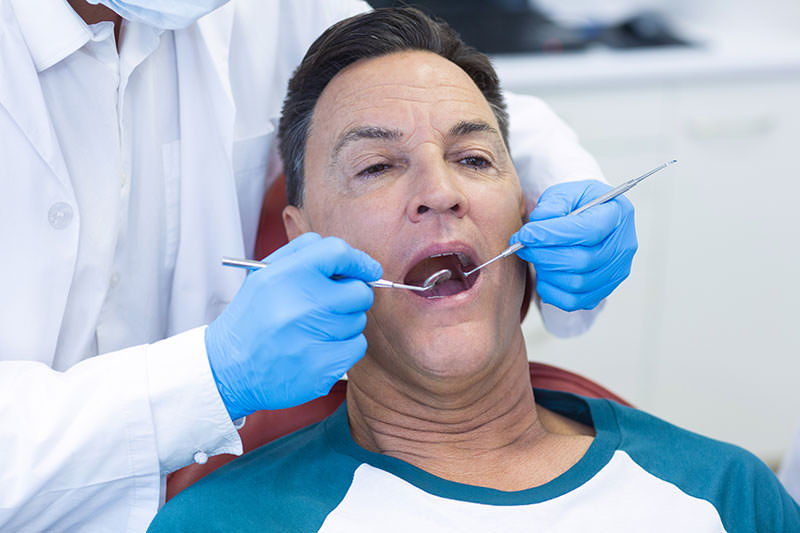
How to Test for Oral Cancer
According to the American Cancer Society, this year around 53,000 people will be diagnosed with oral cancer, and over 10,000 people will die from it. Though oral cancer is a concern for the world population as a whole, some people are more susceptible than others. Men are twice as likely to develop oral cancer as women, while other risk factors include drinking excessively, smoking or chewing tobacco, spending time under the sun, and exposure to the human papillomavirus (HPV).
Fortunately, oral cancer is generally treatable when identified at an early stage. Here, we go over how you can test for oral cancer with an oral cancer self-exam or a screening, and the steps to take if you exhibit any symptoms.
What is Oral Cancer?
Like other cancers, oral cancer occurs when cells grow erratically and become tumors. It can affect different areas of the mouth, including the lips, tongue, cheeks, the hard and soft palate, upper or lower jaw, your sinuses, and your throat. If it’s not caught and treated early on, oral cancer may metastasize and become life-threatening.
The most common form of oral cancer is squamous cell carcinoma, which accounts for more than 90 percent of diagnoses. Other types of cancer or precancerous lesions found in and around the mouth include:
- Verrucous carcinomas
- Minor or major salivary gland carcinomas
- Lymphomas
- Leukoplakia and erythroplakia
- Metastatic cancer lesions
- Other oral cavity or jaw tumors
What Does Cancer in the Mouth Look Like?
Considering the success rate of early treatments, many people wonder:
Is oral cancer visible?
It’s often easy to detect oral cancer visually, even at an early stage. It manifests itself through mouth sores and clearly visible red and white plaques. Persistent discoloration of the tongue may also indicate a health problem. You should examine your mouth each time that you brush and schedule an appointment with your dentist if you notice any irregularities.
Not all oral cancer lesions as symptomatic, some may look very subtle.
Lesions can range from painful ulcerations to small lumps or bumps without pain. Clinical presentation can be very variable.
Oral Cancer Symptoms
Beyond the visible symptoms, there are other signs to look out for when giving yourself an oral cancer exam. Some of the most common symptoms of oral cancer that people experience include:
- Unexplained localized bleeding/swelling around the tongue, gums, or other areas of the mouth
- Sudden numbness or loss of feeling in the face, mouth, lips or throat
- Persistent sores that don’t heal within a two-week timeframe
- Soreness in the mouth, the back of the throat, or in the jaw that does not resolve
- Difficulty chewing, swallowing or speaking
- Hoarseness or a change in voice
- Exposed jaw bone
- Swelling (lumps or bumps) on face or neck region that does not resolve.
- Sudden Weight loss, night sweats
Not all oral cancer lesions as symptomatic, some may look very subtle.
Lesions can range from painful ulcerations to small lumps or bumps without pain. Clinical presentation can be very variable.
Preventing Oral Cancer
The best way to reduce chance of oral cancer is through prevention. By making some simple lifestyle adjustments, you can reduce your risk of developing tumors in or around the mouth. By cutting back or avoiding tobacco and alcohol products altogether, and living a healthy life style, you can significantly reduce your chances of developing oral cancer.
It’s also a good idea to check yourself regularly and schedule an annual screening with a dental health professional. Vaccination against the HPV virus can also reduce your risk of oral cancer, as well as certain cervical and anal cancers.
How to Check for Oral Cancer at Home
It’s a good idea to complete an oral screening at least once per month to check for any signs of oral cancer. The earlier you manage to treat the condition, the higher your chances of success. Fortunately, it’s easy to check yourself for oral cancer in the comfort of your own home.
The Oral Cancer Self-Exam
Giving yourself an oral cancer test at monthly intervals is quick, easy, and may save your life. You should clean your hands before starting your oral cancer exam and have a flashlight on hand. Here’s how to check for oral cancer at home:
- Examine your entire face, checking for any irregularities or changes in the symmetry between the two sides.
- Check both the inside and outside of your lips for changes in texture and color.
- Look at your gums, especially the area around your teeth, and check for bleeding or irregularities.
- Draw back the sides of your mouth and examine the inside of your cheeks for lumps, bumps, or discoloration.
- Check your tongue for irregularities. It’s a good idea to feel it with a finger for any hard lumps.
- Feel around the neck and throat area for any unusual bumps.
- Press down on your thyroid cartilage, more commonly known as your Adam’s Apple. It should move up and down with ease when you swallow.
If you notice anything strange during your oral cancer test, you should schedule an appointment with your dentist immediately. They can give you a more thorough diagnosis and prescribe a treatment.
What Doctor do I Need to See for Oral Cancer?
Most people receive an oral cancer exam during their biannual dentist’s appointment. If, however, you notice irregularities at home during your self-exam, then you may want to schedule a special oral cancer test with your healthcare provider. Any dentist should be able to identify the early signs of oral cancer and help you to take the appropriate steps toward referrals and treatment.
Oral surgeons are usually first line in seeing patients with oral cancer concerns and performing the initial biopsy for diagnosis.
You can also see your doctor or a general practitioner if you’re concerned about oral cancer. With a quick visual examination, your head and neck doctor can determine if you should opt for further testing to identify any unusual growths around your mouth. You may end up having to schedule a follow-up appointment with an oral specialist.
What is an Oral Cancer Screening?
Oral cancer screenings are generally performed by either a dentist or a doctor. During your visit, you can expect your care provider to do a quick visual examination of the inside of your mouth. They’re looking for any unusual bumps or bleeding that may indicate the first stages of oral cancer.
If necessary, your care provider may perform additional tests for oral cancer screening. He or she may ask you to rinse your mouth using a special blue dye that adheres to abnormal cells, making them more clearly visible. They may also perform a biopsy by removing cells from suspicious growths in the mouth and sending them to a lab for testing.
If you test positive for oral cancer, your doctor then has to figure out the extent of the condition, also known as the stage. Cancers are classified in four stages, with stage I indicating a small growth confined to a single area, while stage IV means the cancer is metastatic and has spread to other parts of the body.
For oral cancer, doctors often use a small, flexible camera to examine your throat in a process called endoscopy. A variety of imaging tests can also help to determine the extent of oral cancer, including X-rays, CT scans, MRIs, and PET scans.
Treatments for Oral Cancer
With early intervention, oral cancer is often treatable. The overall survival rate after one year for patients with oral and throat cancers is 81%, while the five-year survival rate is over 50%. The best treatment for oral cancer varies on a case-by-case basis.
Surgery is usually the first line of treatment for oral cancer. For more advanced cases, Chemotherapy and Radiation therapy may also be needed afterwards.
For non-metastatic tumors, an oral surgeon may be able to cut away the cancerous tissue safely. If the cancer has spread to your lymph nodes, they may have to remove these nodes and the surrounding tissue in your neck.
Depending on how much tissue or bone has been removed, your surgeon may also recommend reconstructive surgery after your operation.
For more advanced cases of oral cancer, it may be necessary to use radiation therapy to eliminate abnormal or dangerous growths. High-energy beams such as X-rays or protons are delivered either from outside the body or using internal radioactive seeds and wires to kill cancer cells. Radiation therapy is often used in conjunction with surgery, but it can also be used by itself in early cases of oral cancer.
Chemotherapy is a common treatment for oral cancer in its later stages. Cytotoxic drugs and other chemicals are used to kill off cancerous cells inside the body. Chemotherapy and radiation therapy are often used in combination to enhance the effectiveness of cancer treatment. Unfortunately, however, many patients experience moderate to severe side effects from the procedure. The most common include nausea, vomiting, hair loss, and weight loss. Patients undergoing chemotherapy can talk to their doctor about how to curb unwanted side effects using drugs, holistic medicines, and dietary changes.
When standard treatments don’t work, doctors may turn to therapy using targeted drugs. These medications are designed to interrupt the aberrant growth of cancer cells, helping to prevent tumors from spreading. One of the most common targeted therapy drugs used to treat mouth cancer is Cetuximab (Erbitux), which blocks a certain type of protein that is often found in cancer cells. While targeted drug therapy can be effective, like other treatment, it also comes with side effects such as itching, rashes, headaches, and gastrointestinal issues.
Oral cancer affects families around the world, causing thousands of deaths each year. By being vigilant about your health, you can detect signs of oral cancer early on and increase your chances of having a successful treatment. It’s important to know how to check for oral cancer at home. Luckily, it’s easy to perform a monthly oral cancer self-exam at home to look for visible signs that may be cause for concern. Your doctor or dentist can also help you to identify, diagnose, and treat oral cancer using oral surgery, radiation therapy, chemotherapy, and targeted drug treatments.
Contact NextGen OMS
If you have any questions or concerns, contact Dr. Eftekhari today.


